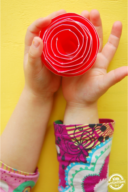Let’s get our hands wet (just a little) with these hands on science experiments exploring water absorption. This kitchen science project for kids of all ages explores water absorption and what happens when you spill water and how best to clean it up in the most absorptive way. This water absorption science project works well at home or in the classroom.

Water Absorption Experiment for Kids
This water absorption project is not only hands on but it is also a great water experiment – and kids love water. The next time you have to clean up a spill and you know which material is the most absorptive and will do the best job, you can thank us here at Kids Activities Blog.
Definition of Absorption
Water absorption is defined as the amount of water absorbed by a material and is calculated as the ratio of the weight of water absorbed to the weight of the dry material.
What Absorption Means to Us
Every day we deal with situations where water absorption is involved, but we may not even be aware. When you dry off after a bath, a more absorbent towel will make that easier. If you watch a paper towel commercial on TV or online, you will see the tests they show to prove their product works better. If you have a baby in the house, diaper absorption is a the difference between sleeping through the night or not!
Absorption in the Real World
My husband tends to run for the paper towels, my son reaches for the napkins that are kept on a shelf at his eye level, and I race for a dish towel. With all of us trying to clean up the spill it seems to take no time at all, but lately I have been wondering what spill removing item really absorbs the most water.
Let’s Test Water Absorption
You could do this as a casual kitchen table science experiment like we did or grab our printable scientific method for kids worksheet and go through these steps with more a more formal set of questions.
My son and I gathered a wide variety of spill removing items from around the house. I then I tried to cut them into similar sizes.
Suggested Supplies to Test Water Absorption

- paper towel
- napkin
- sock
- foam backed letter
- dish towel
- sponge
Directions for Water Absorption Science Experiment
Step 1

We then put a cup of water into the large section of one of my son’s bento lunch containers. The container was called the “Water Absorbing Test Area” for this experiment.
The dry testing materials were put in the left hand side of the container and the wet ones were placed in the right hand side once they had been used.
Step 2

My son placed each material into the water and then the testing material was squeezed out over a silicone muffin cup.
Science Experiment Tip: We learned that you have to hold the material up over the cup rather than put the item in the cup while squeezing it. We ended up with water everywhere and had to redo the test with that material once it had dried.
Step 3

After emptying the water the material contained into the cup, I moved the cup unto a paper labeled with the names of each of the materials.
When we had tested out each materials, I had him look at the amount of water in each cup.
Science Experiment Tip: You could use a measuring cup if you wanted a more specific measurement with older kids.
Step 4
We then discussed why some items like the sponge did a great job and the foam letter absorbed very little water.
My son decided that it had to due with the size of holes each object has. I think that was a very wise insight.
Our Experience with this What Absorbs Water Test
We have had a lot of drink spills at our house. That means that each of us scrambles for something to clean up the liquid that is flowing off the kitchen table and cascading to the floor.
Young children benefit greatly from hands on learning. Preschoolers, Kindergartners and Grade School students are naturally curious which makes them the best scientists.
Water Absorption Science Experiment for Kids

This simple water absorption science experiment for kids can be altered for any age or grade level. Kids will explore the mysteries of how water "disappears" through science!
Materials
- paper towel
- napkin
- sock
- foam backed letter
- dish towel
- sponge
- piece of paper
- marker or pen
Tools
- several kitchen bowls or containers or a multi-section container
- Smaller identical cups - one for each testing item - we used silicone cupcake liners
Instructions
- Start with two containers (or one with two sections). Fill one 1/2 up with water and leave the other dry. The wet container will be the water absorbing test area and the other can hold the dry testing material.
- Place each dry test material into the water absorbing test area to the same depth and remove (you could also add a timed amount)
- Squeeze out the water into your small cups (cupcake liners) and label onto a paper underneath
- Add more water to your water absorbing test area if needed
- Continue with the next item
More Kitchen Science Experiments for Kids
- More absorption science experiments for kids
- Let’s choose from this big list for a fun science activity
- Water absorption activity…let’s make this glop recipe
- So much science and crafty fun with these uses for Easter egg dye
- Make these personalized beach towels
- Check out these science for preschoolers ideas
- Make a battery train together on the kitchen table
- Oh so many fun water activities for kids
- We have so many ideas for other science experiments for kids
- And some more science activities for kids to do at home or in the classroom
- Find out what happens if you drop a penny from the top of the Empire State Building.
- Or these fun summer science experiments!
- Here are some fun bacteria experiment ideas!
- Check out our list of 20 hands on activities for kids!
- Learn about force, friction, and motion with this tug of war science lesson.
- We have a simple surface tension experiment!
Which material was the winner in your water absorption experiment?




















That’s a wonderful way to teach science to the kids, very very nice.
That’s a wonderful way to teach science to the kids, very nice. 🙂